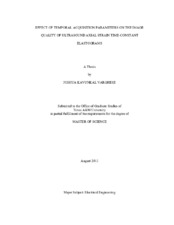| dc.description.abstract | Recent developments in ultrasound elastography have suggested the possibility of using elastographic methods to estimate the temporal mechanical properties of complex tissues. In this context, elastographic methods to image the axial strain time constant (TC) have been developed. The axial strain TC is a parameter that is related to the viscoelastic and poroelastic behavior of tissues. Estimation of this parameter can be done using curve fitting methods. However, the effect of temporal ultrasonic acquisition parameters, such as window of observation, acquisition rate, and input noise, on the image quality of the resultant TC elastograms has not been investigated yet. Elucidating such effects could be useful for diagnostic applications.
This work explores the effects of varying windows of observation, acquisition rate, and input noise on the image quality (accuracy and signal-to-noise ratio (SNR)) of axial strain TC estimates and elastograms using a previously developed simulation model. By varying the amount of data collected as a percentage of the expected TC, the algorithms were able to compute a minimum threshold collection time for an accurate TC estimation as a percentage of the expected TC. The effect of acquisition parameters such as acquisition rate and input noise on the minimum threshold collection time was assessed. Experimental data, collected for previous experiments, were used as a proof of principle to corroborate the simulation findings.
The results of this work suggest that there is a linear dependence of the total acquisition time necessary for accurate TC estimates on the true time constant value. The simulation results also indicate that it might be possible to make accurate estimates of the axial strain TC using small windows of observation (as small as 20% of the expected TC) with fast acquisition rates and high input SNR levels. Experimental results suggest that, in practice, a larger window of observation should be used to account for multiple noise sources typically not considered in simulations. This work also suggests that the minimum window of observation necessary for an accurate TC estimate is highly dependent on the acquisition frame rate and the input SNR level. Therefore, use of imaging systems with fast acquisition rates is recommended for studies aiming at measuring time-dependent phenomena in tissues. | en |


